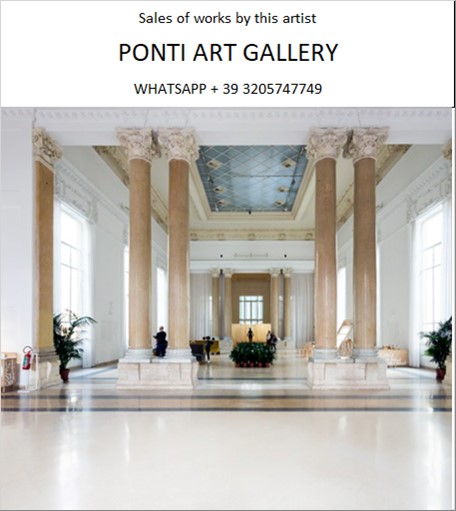Ponti Art Gallery is interested in buying and selling works
of art by this artist.

Omar Onsi Biography
Omar Onsi was a pioneering figure in the modern art movement of Lebanon and is widely recognized as the country's most celebrated impressionist painter. Born in 1901 in Tallet Al-Khayat, Beirut, into the Ottoman Empire, Onsi's early life was steeped in a culture that valued education and the arts. His father, Dr. Abdul Rahman El Ounsi, was a prominent general practitioner and one of the first Beirut Muslims to study modern Western medicine. His mother came from a distinguished Sunni Muslim family known for adopting Western attire. Omar was named after his paternal grandfather, a scholarly poet well-regarded in Beirut.
Despite his father's medical background, Onsi was drawn to the arts from a young age. His father, recognizing his son's artistic inclination, introduced him to art by taking him to the studio of portraitist Habib Serour. However, he insisted that Omar pursue a more practical education. Onsi initially enrolled in medical school at the Syrian Protestant College, which is now known as the American University of Beirut. It was here that his illustrations in a student publication caught the eye of Khalil Saleeby, a painter who invited Onsi to train at his Bliss Street studio. Despite his parents' opposition, Onsi accepted the offer and soon found success in the art world, winning a silver medal at the Beirut International Fair in 1921. This early recognition convinced him to leave medicine and dedicate himself entirely to art.
In 1922, Onsi traveled to Jordan, where he taught art and English to young members of the Jordanian royal family. During his free time, he painted their portraits and captured the essence of Bedouin scenes and desert landscapes. The stark contrast between the harsh sun, dry sands, and the perpetual blue skies of the region deeply inspired him. His stay in Jordan lasted until 1927, during which he enjoyed the patronage of King Abdullah and documented the indigenous peoples both ethnographically and visually.
Seeking to further his education in art, Onsi moved to Paris in 1927 to study at the Académie Julian. There, he closely studied the École de Barbizon and Fontainebleau movements. His time in Paris also led to personal developments; he befriended Lebanese sculptor Youssef Howayek and married Emma Morand. Upon returning to Beirut in 1930, with Morand joining him three years later, Onsi settled into his childhood home. He painted various subjects, including members of his social circles, Lebanese mountains, villages, and the underdeveloped urban landscape of Beirut.
The 1930s were a period of local acclaim for Onsi, marked by several group and solo exhibitions. However, tragedy struck in 1934 when Emma Morand passed away suddenly. Onsi's work for the next five years reflected the melancholy that enveloped his life after her death. In 1939, he found love again and married Marie Bauer, an Alsacian woman who taught at the Collège Protestant Laïque. This new chapter in his life saw a return to his former self.
Onsi's work is characterized by modest colors, textures, and shapes, distinguishing him from his contemporaries. He traveled extensively, exhibiting his work across Europe, the Middle East, and North America. Despite the diversity of landscapes he depicted, his most frequented theme remained Lebanon. His style, influenced by Impressionism and other European trends, captured mountains, hills, forests, villages, rural houses, and urban scenes with a unique perspective.
Onsi's career was not only about creating art but also about contributing to the cultural fabric of Lebanon. He was actively engaged in founding national art institutions and promoting cultural pedagogy. His work had a civically oriented, domestic aesthetic that resonated with many.
Omar Onsi's legacy as a skilled paysagiste—a landscape painter—was well-established during his lifetime. He continued to produce landscapes in significant numbers and commanded higher prices for his work. The local press praised him, and his career flourished. He continued to travel and exhibit his work in the 1940s and 50s, with shows in Germany, Spain, Italy, and Egypt.
Onsi's life came to an end on June 3, 1969, in Beirut, after a battle with stomach cancer. His death marked the loss of a significant figure in Lebanese art. Alongside contemporaries such as Mustafa Farrukh, César Gemayel, Saliba Douaihy, and Rachid Wehbi, Onsi's contributions to the art world have left an indelible mark. His work continues to be celebrated, with retrospectives and exhibitions, such as the Omar Onsi Retrospective at the Sursock Museum in Beirut in 1997 and the Art from Lebanon exhibition at the Beirut Exhibition Center in 2012. His paintings, such as "Bedouin" (1926), "Beirut" (pre-1930), "A Passage to Lebanon" (1931), and "View of Hauran" (1935), among others, remain highly regarded and continue to captivate audiences with their timeless beauty and cultural significance.
Omar Onsi Quotes and Sales of
Works
Ponti Art Gallery selects and deals with paintings by the
artist. Upon request, we provide free estimates and
evaluations, communicate prices, quotations, and current
market values.
If you are interested in BUYING or SELLING works by the
artist, contact us immediately.
If you wish to sell or receive an evaluation of the
works:
Send us a frontal photo of the painting, one of the back,
and one of the signature. Also, indicate the dimensions of
the work. Inform us about the purchase origin of the work
and any kind of available documentation (purchase
receipts, certificates of authenticity, publications). One
of our operators will respond to you on the same day. We
guarantee maximum confidentiality and extreme
professionalism.
If you wish to purchase works by the painter: Contact us
and let us know your request. We will inform you about the
available works. We also offer the possibility to
subscribe to our NEWSLETTER, through which you will be
informed at the beginning of each month about the latest
acquisitions of the art gallery.
You can send us pictures of the work:
